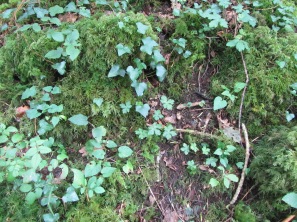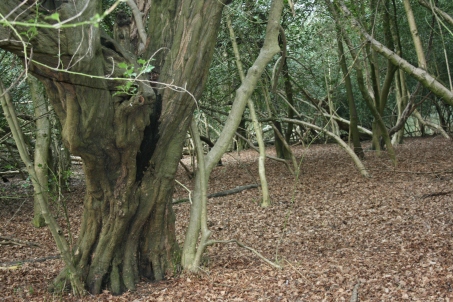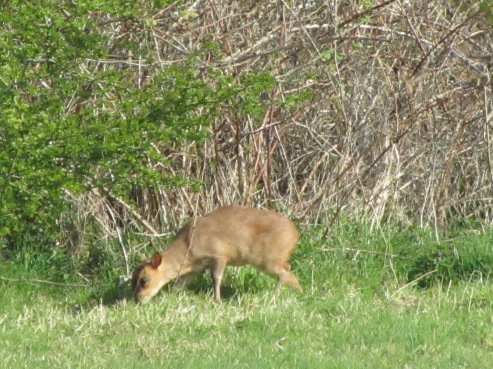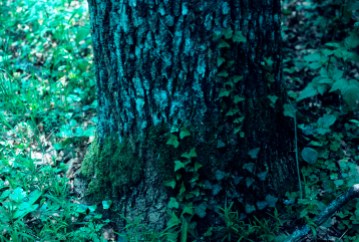WHolly and ivy are so strongly associated with Christmas that the carols start in my head, even as I write. The winter greenery was a sign of hope and renewal in the dark, cold, days of winter. The Green Knight who challenges Gawain at King Arthur’s Christmas feast carried a holly bob as a sign of peace. The holly was seen as the male and the ivy as the female partner in this evergreen relationship. This is somewhat un-PC. Holly has both male and female trees and the female trees bear the berries that are the focus of the carols.
Ivy berries and holly leaves
The Scandinavian ecologist Johs Iversen, noted back in 1944, noted that the abundance of these species in north-west Europe seemed to be strongly limited by winter temperature (Iversen, 1944). On visits to Estonia and Poland there was a big grin of our hosts’ faces as they took us to see a ‘rare plant’ which turned out to be ivy. In Bialowieza Forest I was told it rarely gets more than 30 cm high because if it got any taller it would be above the protection of winter snow. By contrast with us its stems can be more than 10 cm across, circling its host, branching and fusing in a rough network.
Ivy trying to keep below the snow in Poland and the dense network of stems on a Norfolk oak.
Quite often, I was ‘phoned up by someone concerned that their trees were being strangled by ivy growth, but there is little evidence that this is the case (Patch, 2004) . Trees may indeed carry dense ivy foliage, but if they are healthy they should be able to outgrow the new growth each year with little problem. The whole trunk gets overtopped usually only where the tree is weakened by other factors, for example where hedgerow elms have succumbed to Dutch Elm Disease. The increased ‘sail’ area provided by the ivy leaves may however increase the risk of windblow.
I therefore get annoyed by ivy trunks that have been deliberately cut through, often, not by the owners or managers of the trees, but by guerrilla ‘conservationists’. They forget that the ivy stems and leaves are important shelter and foraging areas for small birds, that ivy flowers are a critical source of late nectar for insects, while the berries provide an important food source for birds and small mammals.
Ivy does not just climb over the trees; it can dominate the ground flora as well, where it is rather a thuggish plant (Marrs et al., 2013). In Eastern England this usually indicates recently formed woods, such as the ‘Broadbalk Wilderness’; this is a little bit of a field left idle in the late nineteenth century and now a self-sown ash-oak woodland. Ivy is well-adapted to cope with the dense shade found in such young woods. It may also benefit from the increases in nitrogen deposition from the atmosphere, from cars, power stations, fertilizers applied to adjacent fields. It is however a regular component of ancient ashwoods in the milder ‘Atlantic’ parts of Britain.


Ivy carpet in Broadbalk Wilderness (a recent woodland) and in an ancient gorge woodland in Cumbria.
Holly is also spreading: warmer winters may be part of the story, as suggested in Denmark (Walther et al., 2005), but holly spread is also linked to changes in woodland grazing patterns. Holly was widely encouraged in medieval forests and parks, and on some commons, as a winter food for deer and livestock. Its leaves are rich in nutrients. Though the lower ones are prickly, this does not stop them being eaten and the upper leaves generally lack this defence. It has been suggested that prickly shrubs such as holly protect young oaks and that is why the two species are often associated. However the converse can also be true. In Dalkeith Old Park there seems to be a strong association between old oaks and young hollies – I suspect that the holly is regenerating from seeds dropped by birds that perch on the oaks.
A view of the Stiperstones, one of the best surviving holly wood-pastures; holly regeneration at the base of the oaks in Dalkeith Old Park
Where the grazing has been abandoned holly has often spread to form dense thickets, which are about as interesting botanically as rhododendron clumps.

The exciting flora found under dense holly thickets in Epping Forest.
Ivy also produces two sorts of leaves – the typical star-shaped lower leaves and the more rounded upper ones. It may be that the upper leaves, as well as being a different shape, have fewer defensive chemicals but I am not sure this has been looked at. What is clear is that, even with an acrid sap and poisonous berries, ivy is popular with a range of herbivores. There is even a song about ivy browsing that reached no 1 in the charts in 1944:
Mairzy doats and dozy doats and liddle lamzy divey; A kiddley divey too, wooden shoe
(or Mares eat oats and does eat oats and little lambs eat ivy; a kid will eat ivy, too; wouldn’t you? NOT to be recommended for human kids!)
Dr Arnold Cooke, formerly of the Nature Conservancy Council and English Nature, made use of this love of ivy to help judge the deer pressure in Monks Wood (Cooke, 2006). Groups of sprigs of ivy were set out in different areas and then checked over the next week. The deer impact was roughly related to how many of the sprigs have been damaged after one and seven days.

So, as you decorate your house with evergreens and sing the carols, remember what roles these plants are playing the rest of the year.
COOKE, A. S. 2006. Monitoring Muntjac Deer Muntiacus Reevesi and Their Impacts in Monks Wood National Nature Reserve. . English Nature Research Report Peterborough: English Nature.
IVERSEN, J. 1944. Viscum, Hedera and Ilex as climate indicators: A contribution to the study of the post-glacial temperature climate. Geologiska Föreningen i Stockholm Förhandlingar, 66, 463-483.
MARRS, R. H., KIRBY, K. J., LE DUC, M. G., MCALLISTER, H. A., SMART, S. M., OKSANEN, J., BUNCE, R. G. H. & CORNEY, P. M. 2013. Native dominants in British woodland – a potential cause of reduced species-richness. New Journal of Botany, 3.
PATCH, D. 2004. Ivy – boon or bane. Arboricultural Practice Note, 10, 12.
WALTHER, G.-R., BERGER, S. & SYKES, M. T. 2005. An ecological ‘footprint’of climate change. Proceedings of the Royal Society of London B: Biological Sciences, 272, 1427-1432.









Thanks Keith – always something new in your blog. Rachel
LikeLike